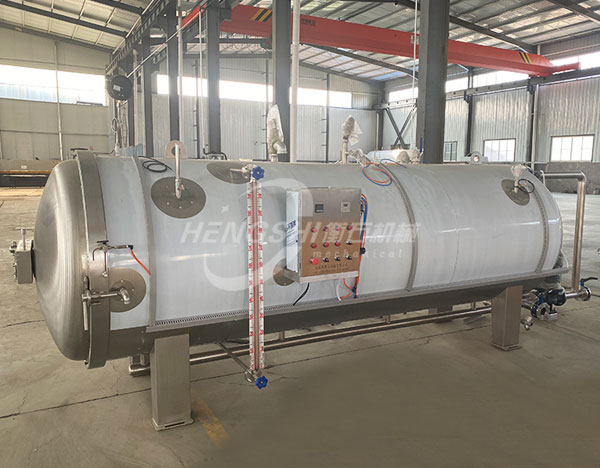Introduction of steam sterilizer:
1. The method of steam sterilization, when the sterilization pot is filled with the goods to be sterilized, and the door is closed and sealed, first open the sterilization pot bleed valve, and then open the sterilization pot heating valve to exhaust the cold air in the pot. When the temperature in the pot reaches 90-95℃, close the air release valve and continue to heat up the pot until the required temperature for sterilization. Close the temperature-raising valve of the sterilization pot. The constant temperature will start when the temperature in the pot is low. When the temperature in the pot rises to the required temperature for sterilization, close the heating valve until the end of the constant temperature. (The condensed water generated in the sterilization pot during the heating and constant temperature process is automatically discharged through the trap). When the pressure in the pot is high, open the bleed valve of the sterilization pot to reduce the pressure in the pot to the specified sterilization pressure; when the pressure in the pot is low, open the air supply valve of the sterilization pot to reduce the pressure in the pot to the specified sterilization pressure .
2. Automatic steam sterilization pot, when the sterilization pot is filled with goods to be sterilized, and the door is closed and sealed, the sterilization pot vent valve is automatically opened, and then the sterilization pot heating valve is automatically opened to exhaust the cold air in the pot. When the temperature in the pot reaches 90-95°C, the vent valve of the sterilization pot will be automatically closed (already set), and the pot will continue to heat up until the set temperature that needs to be sterilized, and the temperature rise valve of the sterilization pot will be automatically closed, and the constant temperature will start automatically. , When the temperature in the pot is low, the heating valve will automatically open to increase the temperature, and when it rises to the set temperature that needs to be sterilized, the heating valve will automatically close. The pressure, temperature and constant temperature time in the pot are under fully automatic control. When the constant temperature is over, the heating valve will automatically close and no longer heat up the sterilization pot. The condensed water generated in the sterilization pot during the heating and constant temperature process is automatically discharged through the trap.
3. Cooling after the end of constant temperature, adopt different cooling methods according to different packaging, horse
Iron cans generally use top spraying to cool down; aluminum cans use heat exchangers for indirect heat exchange and cooling, and flexible packaging and plastic bottles generally use bottom flooding to cool down.
Equipment use:
The purpose of the equipment, the purpose of high temperature sterilization is to sterilize various products suitable for high temperature sterilization, so that the products can be stored at normal temperature for a longer time, and users can produce in large quantities. It is more conducive to long-distance transportation. In a certain period of time, the product will not contact the outside world, so that the product can be stored for a long time without deterioration. The function of the rotary sterilizer is mainly used in the production of milk and eight-treasure porridge. During the high-temperature sterilization process, the product is rotated in the pot to solve various viscosity, such as milk, eight-treasure porridge, and canned, bowled, and bottled with solids. The food does not delaminate or precipitate during the shelf life.
